Glyphosate- and Imazapic-Resistant Chloris virgata Populations in the Southeastern Cropping Region of Australia
Abstract
1. Introduction
2. Material and Methods
2.1. Seed Collection
2.2. Herbicide Screening
2.3. Statistical Analyses
3. Results and Discussion
3.1. ACCase-Inhibitors
3.2. Glyphosate
3.3. Imazapic
Author Contributions
Funding
Data Availability Statement
Conflicts of Interest
References
- Llewellyn, R.S.; Ronning, D.; Ouzman, J.; Walker, S.; Mayfield, A.; Clarke, M. Impact of Weeds on Australian Grain Production: The Cost of Weeds to Australian Grain Growers and the Adoption of Weed Management and Tillage Practices. Report for GRDC; CSIRO: Canberra, Australia, 2016; p. 112. [Google Scholar]
- Manalil, S.; Mobli, A.; Chauhan, B.S. Competitiveness of windmill grass (Chloris truncata) and feathertop Rhodes grass (Chloris virgata) in mungbean (Vigna radiata). Crop Pasture Sci. 2020, 71, 916–923. [Google Scholar] [CrossRef]
- Mahajan, G.; Chauhan, B.S. Evaluation of preemergent herbicides for Chloris virgata control in mungbean. Plants 2021, 10, 1632. [Google Scholar] [CrossRef]
- Squires, C.; Mahajan, G.; Walsh, M.; Chauhan, B.S. Effect of planting time and row spacing on growth and seed production of junglerice (Echinochloa colona) and feather fingergrass (Chloris virgata) in sorghum. Weed Technol. 2021, 35, 974–979. [Google Scholar] [CrossRef]
- Desai, H.S.; Chauhan, B.S. Differential germination characteristics of glyphosate-resistant and glyphosate-susceptible Chloris virgata populations under different temperature and moisture stress regimes. PLoS ONE 2021, 16, e0253346. [Google Scholar] [CrossRef]
- Chauhan, B.S.; Manalil, S. Seedbank persistence of four summer grass weed species in the northeast cropping region of Australia. PLoS ONE 2022, 17, e0262288. [Google Scholar] [CrossRef]
- Ngo, T.D.; Boutsalis, P.; Preston, C.; Gill, G. Growth, development, and seed biology of feather fingergrass (Chloris virgata) in Southern Australia. Weed Sci. 2017, 65, 413–425. [Google Scholar] [CrossRef]
- Fernando, N.; Humphries, T.; Florentine, S.K.; Chauhan, B.S. Factors affecting seed germination of feather fingergrass (Chloris virgata). Weed Sci. 2016, 64, 605–612. [Google Scholar] [CrossRef]
- Heap, I. The International Herbicide-Resistant Weed Database. 2022. Available online: http://www.weedscience.org (accessed on 2 October 2022).
- Desai, H.S.; Thompson, M.; Chauhan, B.S. Target-site resistance to glyphosate in Chloris virgata biotypes and alternative herbicide options for its control. Agronomy 2020, 10, 1266. [Google Scholar] [CrossRef]
- Ngo, T.D.; Krishnan, M.; Boutsalis, P.; Gill, G.; Preston, C. Target-site mutations conferring resistance to glyphosate in feathertop Rhodes grass (Chloris virgata) populations in Australia. Pest Manag. Sci. 2018, 74, 1094–1100. [Google Scholar] [CrossRef]
- Manalil, S.; Werth, J.; Jackson, R.; Chauhan, B.; Preston, C. An assessment of weed flora 14 years after the introduction of glyphosate-tolerant cotton in Australia. Crop Pasture Sci. 2017, 68, 773–780. [Google Scholar] [CrossRef]
- GRDC. Integrated Weed Management of Feathertop Rhodes Grass; GRDC: Kingston, ACT, Australia, 2020; p. 35. [Google Scholar]
- Genstat. Genstat for Windows; Version 21.1.2.25781; VSN International: Hemel Hempstead, UK, 2021. [Google Scholar]
- Singh, V.; Maity, A.; Abugho, S.; Swart, J.; Drake, D.; Bagavathiannan, M. Multiple herbicide–resistant Lolium spp.is prevalent in wheat production in Texas Blacklands. Weed Technol. 2020, 34, 652–660. [Google Scholar]
- Boutsalis, P.; Gill, G.S.; Preston, C. Incidence of herbicide resistance in rigid ryegrass (Lolium rigidum) across southeastern Australia. Weed Technol. 2012, 26, 391–398. [Google Scholar] [CrossRef]
- Saini, R.K.; Malone, J.; Preston, C.; Gill, G. Target enzyme-based resistance to clethodim in Lolium rigidum populations in Australia. Weed Sci. 2015, 63, 946–953. [Google Scholar] [CrossRef]
- Chauhan, B.S.; Congreve, M.; Mahajan, G. Management options for large plants of glyphosate-resistant feather fingergrass (Chloris virgata) in Australian fallow conditions. PLoS ONE 2021, 16, e0261788. [Google Scholar] [CrossRef] [PubMed]
- Werth, J.; Boucher, L.; Thornby, D.; Walker, S.; Charles, G. Changes in weed species since the introduction of glyphosate-resistant cotton. Crop Pasture Sci. 2013, 64, 791–798. [Google Scholar] [CrossRef]
- Powles, S.B. Evolved glyphosate-resistant weeds around the world: Lessons to be learnt. Pest Manag. Sci. 2008, 64, 360–365. [Google Scholar] [CrossRef]
- Barroso, A.A.M.; Albrecht, A.J.P.; Dos Reis, F.C.; Placido, H.F.; Toledo, R.E.; Albrecht, L.P.; Filho, R.V. Different glyphosate susceptibility in Chloris polydactyla accessions. Weed Technol. 2014, 28, 587–591. [Google Scholar] [CrossRef]
- Bracamonte, E.; da Silveira, H.M.; la Cruz, R.A.-D.; Domínguez-Valenzuela, J.A.; Cruz-Hipolito, H.E.; De Prado, R. From tolerance to resistance: Mechanisms governing the differential response to glyphosate in Chloris barbata. Pest Manag. Sci. 2018, 74, 1118–1124. [Google Scholar] [CrossRef]
- Chauhan, B.S.; Jha, P. Glyphosate resistance in Sonchus oleraceus and alternative herbicide options for its control in Southeast Australia. Sustainability 2020, 12, 8311. [Google Scholar] [CrossRef]
- McWhorter, C.G.; Jordan, T.N.; Wills, G.D. Translocation of 14C-glyphosate in soybeans (Glycine max) and Johnsongrass (Sorghum halepense). Weed Sci. 1980, 28, 113–118. [Google Scholar] [CrossRef]
- Nguyen, T.H.; Malone, J.M.; Boutsalis, P.; Shirley, N.; Preston, C. Temperature influences the level of glyphosate resistance in barnyardgrass (Echinochloa colona). Pest Manag. Sci. 2016, 72, 1031–1039. [Google Scholar] [CrossRef] [PubMed]
- Vila-Aiub, M.M.; Gundel, P.E.; Yu, Q.; Powles, S.B. Glyphosate resistance in Sorghum halepense and Lolium rigidum is reduced at suboptimal growing temperatures. Pest Manag. Sci. 2013, 69, 228–232. [Google Scholar] [CrossRef] [PubMed]
- Waldecker, M.A.; Wyse, D.L. Soil moisture effects on glyphosate absorption and translocation in common milkweed (Asclepias syriaca). Weed Sci. 1985, 33, 299–305. [Google Scholar] [CrossRef]
- Tranel, P.J.; Wright, T.R. Resistance of weeds to ALS-inhibiting herbicides: What have we learned? Weed Sci. 2002, 50, 700–712. [Google Scholar] [CrossRef]
- Walsh, M.; Newman, P.; Powles, S. Targeting weed seeds in-crop: A new weed control paradigm for global agriculture. Weed Technol. 2013, 27, 431–436. [Google Scholar] [CrossRef]
- Widderick, M.; McLean, A. Optimal intervals differ for double knock application of paraquat after glyphosate or haloxyfop for improved control of Echinochloa colona, Chloris virgata and Chloris truncata. Crop Prot. 2018, 113, 1–5. [Google Scholar] [CrossRef]
- Werth, J.; Thornby, D.; Keenan, M.; Hereward, J.; Chauhan, B.S. Effectiveness of glufosinate, dicamba, and clethodim on glyphosate-resistant and -susceptible populations of five key weeds in Australian cotton systems. Weed Technol. 2021, 35, 967–973. [Google Scholar] [CrossRef]

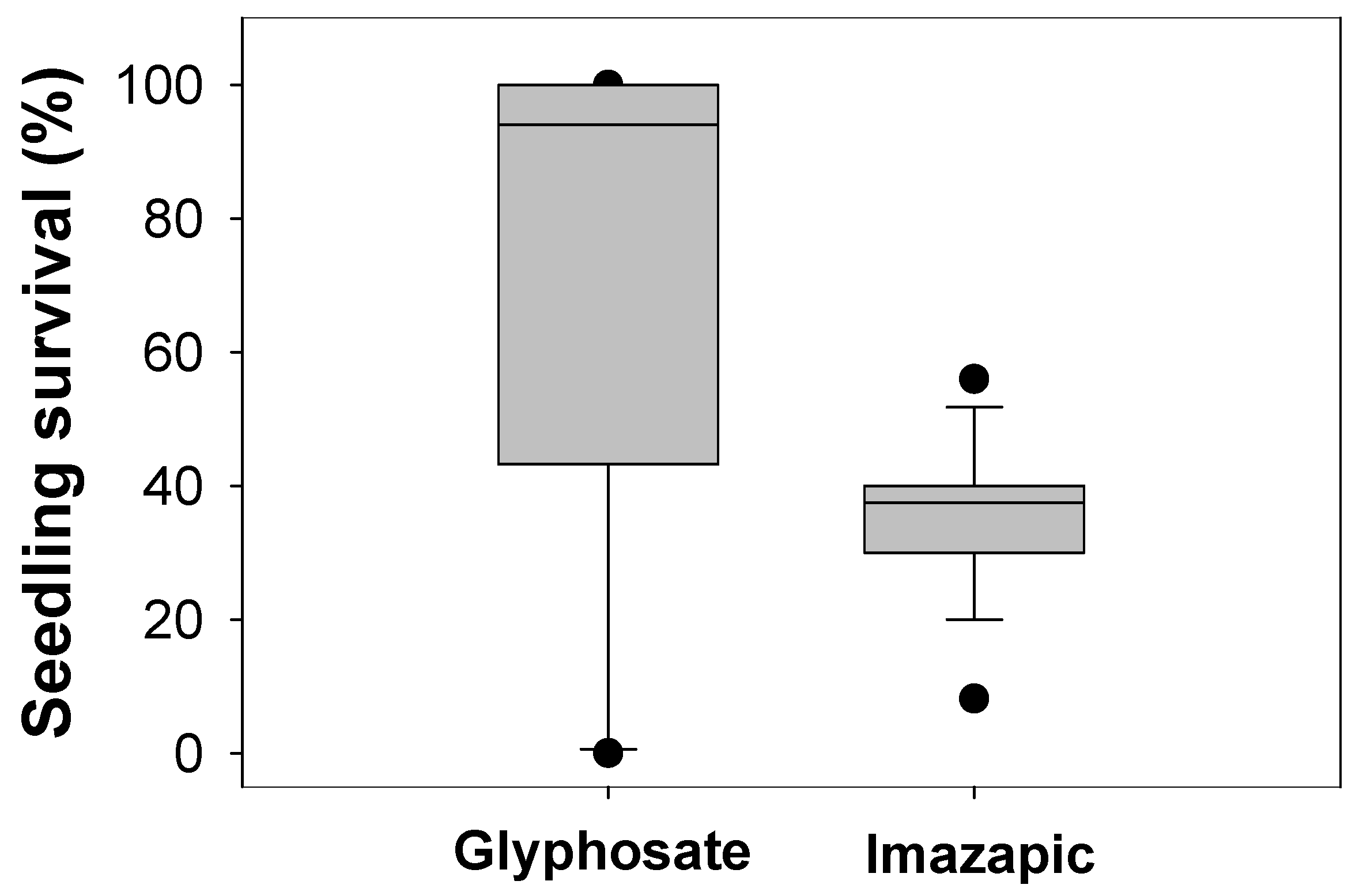
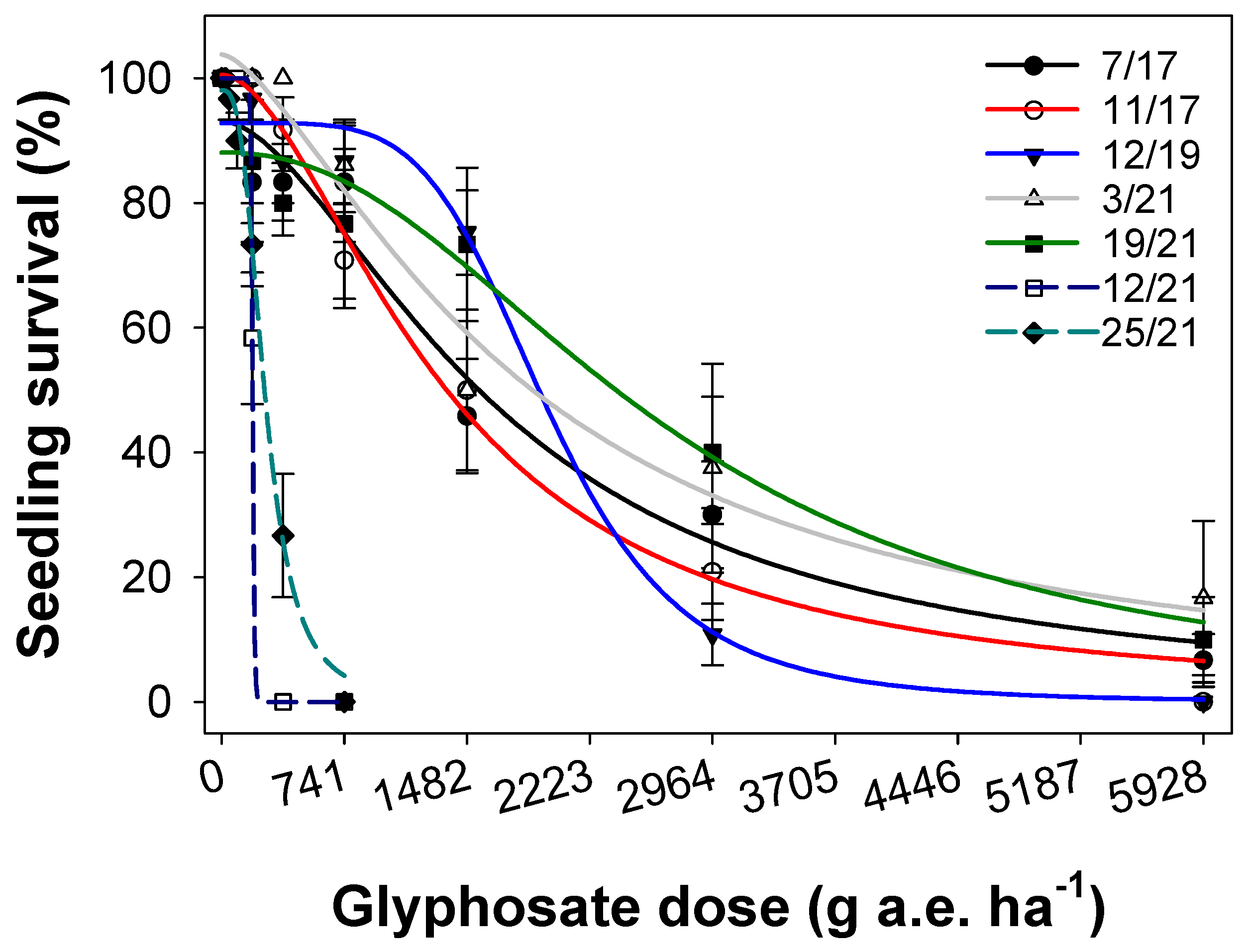
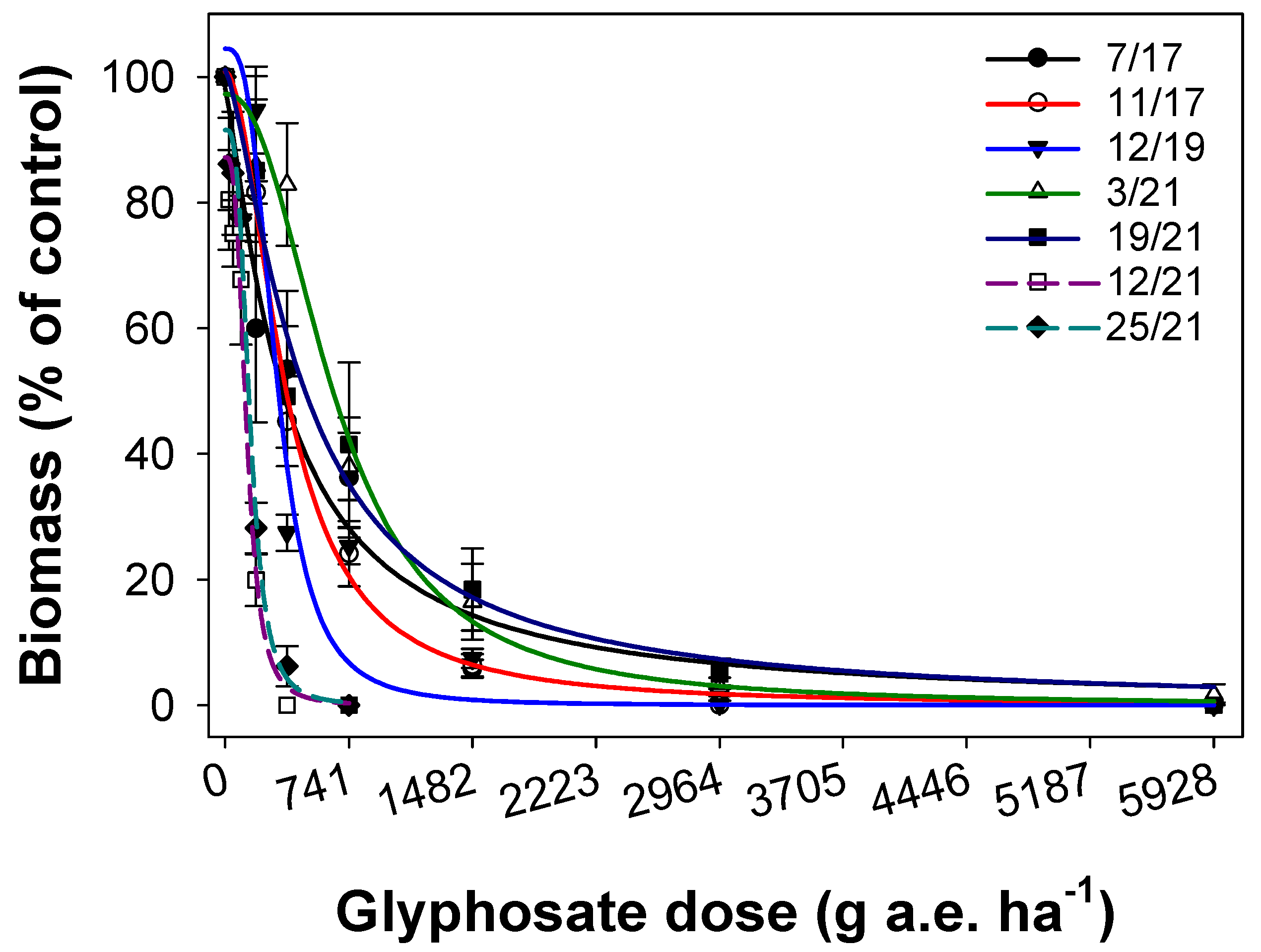
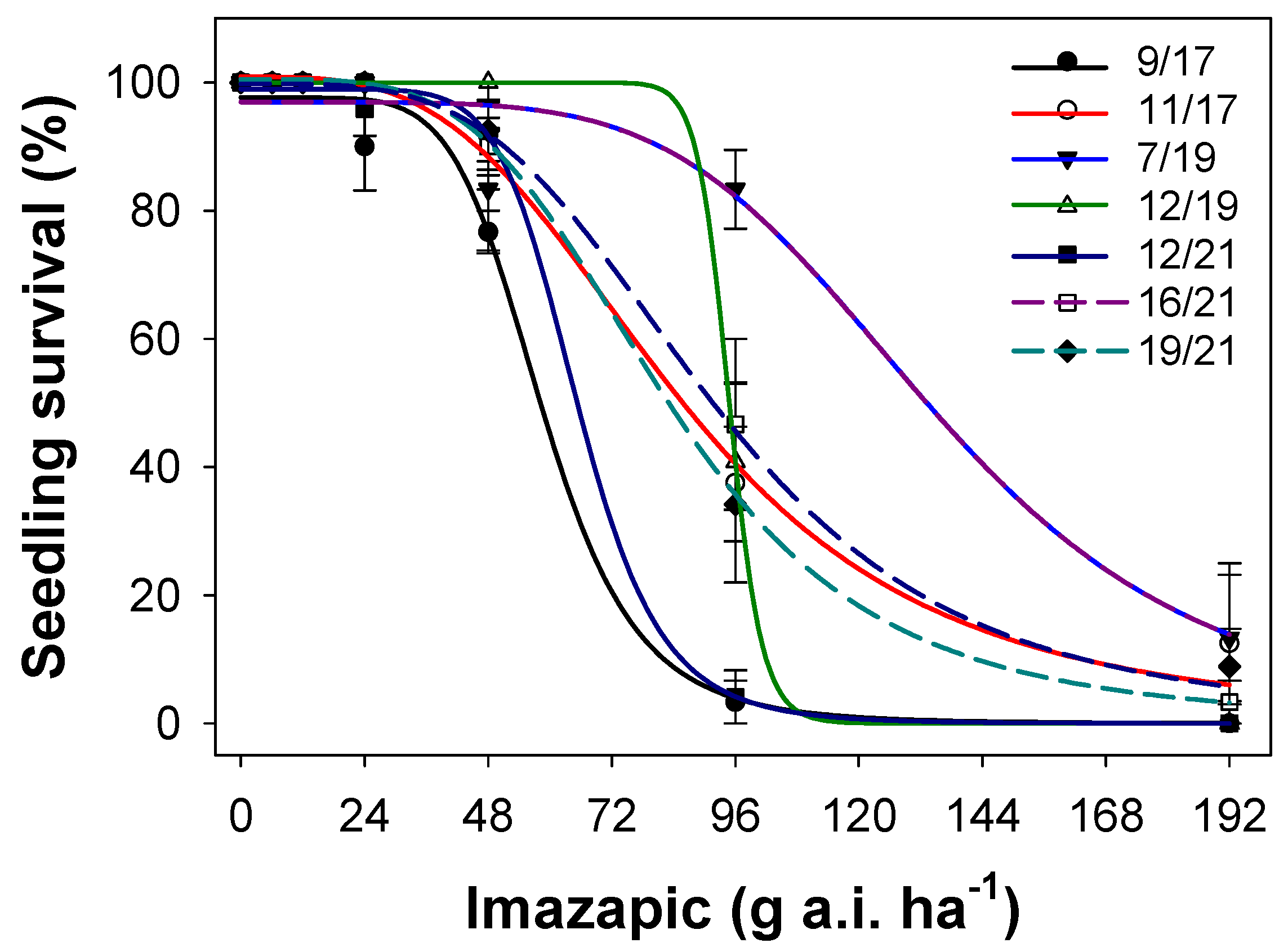
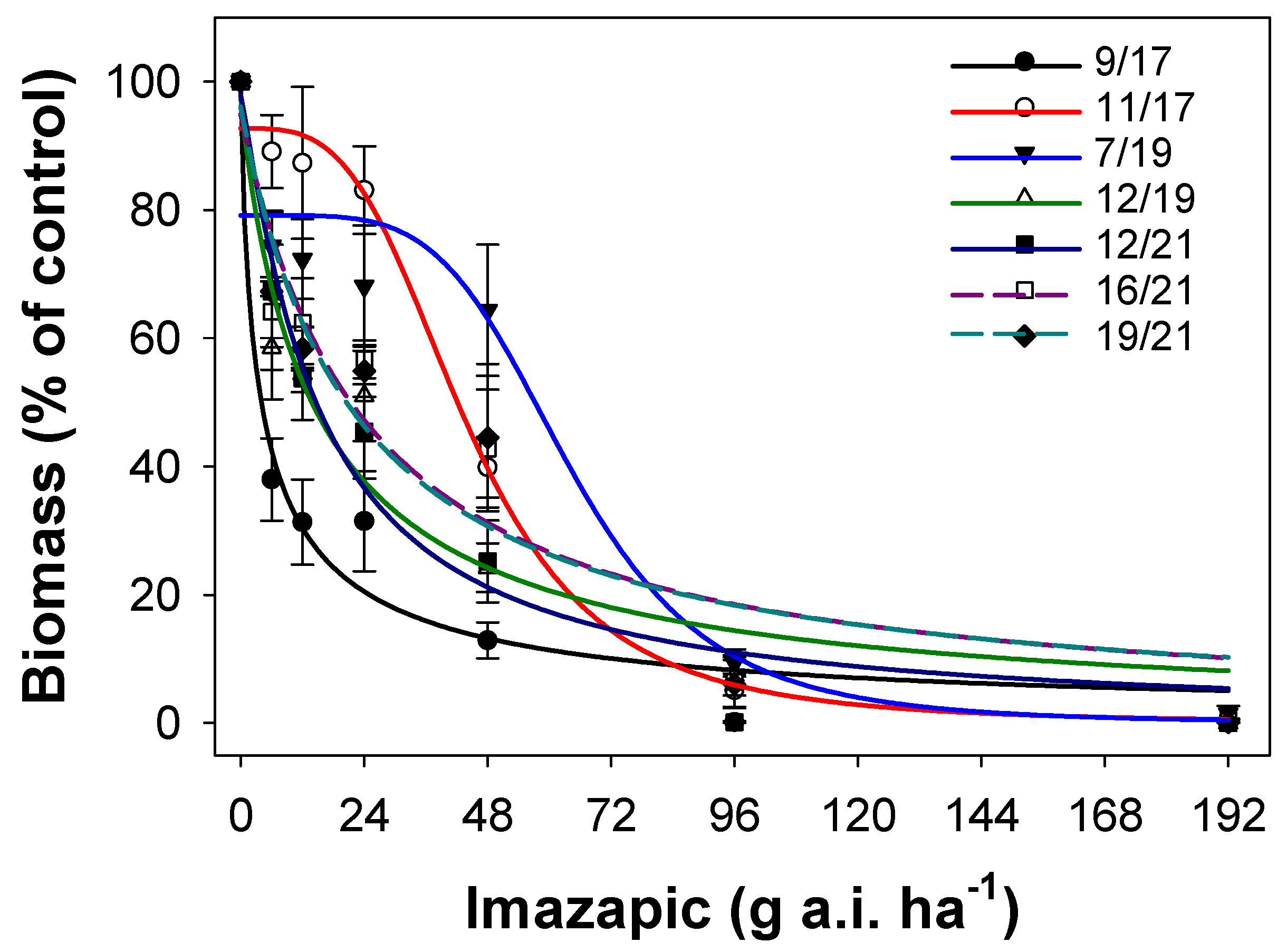
| Herbicide | Highly Resistant a | Moderately Resistant b | Slightly Resistant c | Susceptible d |
|---|---|---|---|---|
| –––––––––––% of the population––––––––––– | ||||
| Clethodim | 0 | 0 | 0 | 100 |
| Glyphosate | 57.5 | 27.5 | 5 | 10 |
| Haloxyfop | 0 | 0 | 0 | 100 |
| Imazapic | 2.5 | 85 | 12.5 | 0 |
| Population | LD50 | RI | GR50 | RI |
|---|---|---|---|---|
| ––g a.e. ha−1–– | ––g a.e. ha−1–– | |||
| 7/17 | 1692 | 9.0 | 355 | 2.8 |
| 11/17 | 1351 | 7.2 | 262 | 2.0 |
| 12/19 | 1979 | 10.6 | 308 | 2.4 |
| 3/21 | 1789 | 9.6 | 662 | 5.1 |
| 12/21 | 187 | 1.0 | 129 | 1.0 |
| 19/21 | 2689 | 14.4 | 471 | 3.7 |
| 25/21 | 262 | 1.4 | 148 | 1.1 |
| Population | LD50 | RI | GR50 | RI |
|---|---|---|---|---|
| ––g a.i. ha−1–– | ––g a.i. ha−1–– | |||
| 9/17 | 59 | 1.0 | 4 | 1.0 |
| 11/17 | 85 | 1.4 | 44 | 11.0 |
| 7/19 | 135 | 2.3 | 64 | 16.0 |
| 12/19 | 95 | 1.6 | 15 | 3.8 |
| 12/21 | 65 | 1.1 | 15 | 3.8 |
| 16/21 | 92 | 1.6 | 24 | 6.0 |
| 19/21 | 83 | 1.4 | 22 | 5.5 |
Disclaimer/Publisher’s Note: The statements, opinions and data contained in all publications are solely those of the individual author(s) and contributor(s) and not of MDPI and/or the editor(s). MDPI and/or the editor(s) disclaim responsibility for any injury to people or property resulting from any ideas, methods, instructions or products referred to in the content. |
© 2023 by the authors. Licensee MDPI, Basel, Switzerland. This article is an open access article distributed under the terms and conditions of the Creative Commons Attribution (CC BY) license (https://creativecommons.org/licenses/by/4.0/).
Share and Cite
Chauhan, B.S.; Mahajan, G. Glyphosate- and Imazapic-Resistant Chloris virgata Populations in the Southeastern Cropping Region of Australia. Agronomy 2023, 13, 173. https://doi.org/10.3390/agronomy13010173
Chauhan BS, Mahajan G. Glyphosate- and Imazapic-Resistant Chloris virgata Populations in the Southeastern Cropping Region of Australia. Agronomy. 2023; 13(1):173. https://doi.org/10.3390/agronomy13010173
Chicago/Turabian StyleChauhan, Bhagirath Singh, and Gulshan Mahajan. 2023. "Glyphosate- and Imazapic-Resistant Chloris virgata Populations in the Southeastern Cropping Region of Australia" Agronomy 13, no. 1: 173. https://doi.org/10.3390/agronomy13010173
APA StyleChauhan, B. S., & Mahajan, G. (2023). Glyphosate- and Imazapic-Resistant Chloris virgata Populations in the Southeastern Cropping Region of Australia. Agronomy, 13(1), 173. https://doi.org/10.3390/agronomy13010173







